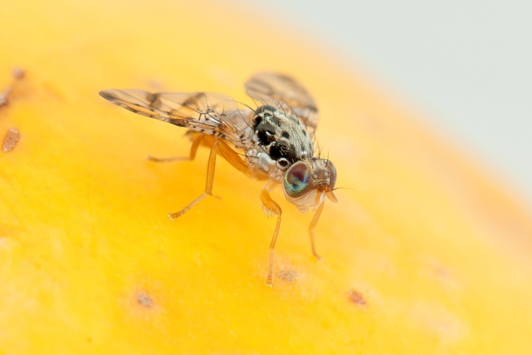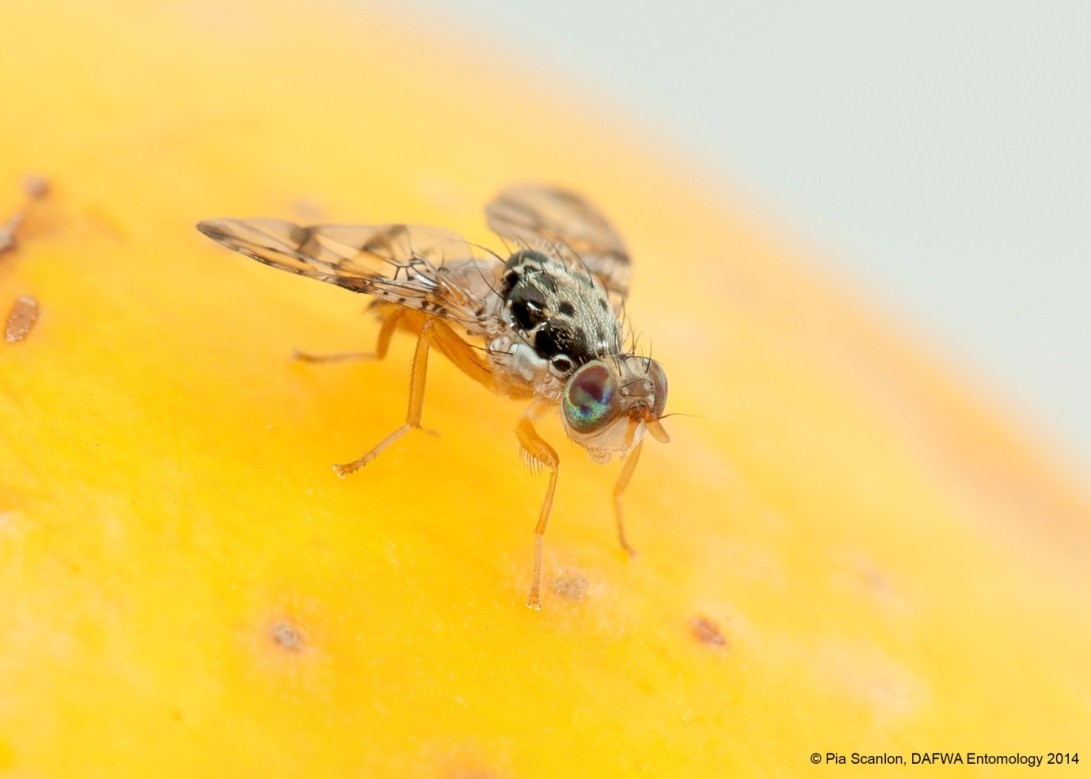
Medfly is a declared pest in WA
Medfly is now endemic to WA. However, Medfly is a declared pest and is mandatory to control in some areas including Carnarvon, Armadale, Kalamunda, Mundaring, Serpentine-Jarrahdale and Swan.
See below for control options. If you suspect your plants are stung by or infected with Medfly or any other fruit fly, please report it.
What is the mediterranean fruit fly?
Mediterranean fruit fly, or Medfly (Ceratitis capitata) is a serious horticultural pest in WA.
Medfly is thought to originate in Africa. It was discovered in Claremont in 1895 and is now found throughout WA from Esperance through to Carnarvon. It is present in Broome and Derby, but absent from the Ord River Irrigation Area (ORIA, Kununurra). The main area of infestation extends from Perth through to Bunbury, Bridgetown, Donnybrook, and Manjimup.
Medfly or Qfly?
Don't confuse Medfly for Queensland fruit fly (Qfly), which is larger and reddish brown and has clear wings. Refer to the Qfly page for more identifying information.
Learn about QflyAbout medfly
Mediterranean fruit fly attacks and damages a wide range of cultivated fruits and some fruiting vegetables. Medfly, as it is commonly known, has been recorded to infest more than 200 hosts worldwide.
Host plant selection
The selection of host plants by Medfly is closely related to their reproductive behaviour.
Males choose newly ripening fruit as mating areas and females will prefer ripening fruit with soft skin where they can lay their eggs, such as apricots, peaches, plums and nectarines. When Medfly numbers are high and competition is greater, or when preferred hosts are not available, females will infest less preferred hosts such as olives or Indian sandalwood.
Host plants provide the nutrients required by the immature stage (larval stages) to complete development from eggs to adult and provide shelter during summer and winter. Adult Medfly do not feed on fruits, rather they feed on animal faeces and nectar, while the larvae feed on (in) fruits and the pupae develop in soil.
Host plant range and ripeness
Medfly abundance and level of infestation (in a particular area) is related to the range and ripeness of hosts and the time these fruits are available.
- Several different hosts with different fruiting seasons will sustain Medfly all year round.
- Affected fruit varieties will depend on species present in a particular location.
Medfly may shelter in other plants including ornamentals found in or around your property.
If you have any host plants in your garden, hobby farm or plantation, please implement a Medfly control program that also includes setting up traps in non-host plants.
List of known host plants in WA
In WA the most commonly infested fruit include apricots, nectarines, peaches, mangoes, persimmons, apples, pears and mandarins.
High susceptibility
|
Apricots |
Mango |
Peach |
Orange |
|
Plum |
Mandarin |
Nectarine |
Pear |
|
Fig |
Guava |
Loquat |
Grape |
Medium susceptibility
|
Apple |
Bell or wax apple |
Tomato (over ripe) |
Papaya, paw paw |
|
Cherry |
Grapefruit |
Quince |
Star fruit, carambola |
Low susceptibility
|
Lemon (certain varieties) |
Lime |
Olive |
Custard apple |
|
Avocado (certain varieties) |
soursop |
Prickly Pear |
Curry tree |
|
Ducass banana |
Indian sandalwood |
|
|
The first sign of damage is often larvae-infested or ‘stung’ fruit. Stinging is caused by the female laying eggs into unripened or ripe fruit.
Damaged fruit
Bruising on the outside of ripe fruit can be the first sign of a Medfly larvae infestation. Sometimes the bruise may be around a central hole where the eggs were inserted by the female Medfly. However, fruit that looks perfect on the outside can still be infested with larvae or eggs, as it can take a few weeks for bruising to appear on the fruit skin.
Medfly larvae also damage the inside of the fruit as they eat it, resulting in bruised and broken fruit flesh. Medfly larvae can be found in fruit that is both on the tree or fallen on the ground., however it is important to note that while medfly larvae may be present in fallen fruit, they do not infest fruit that has already fallen.
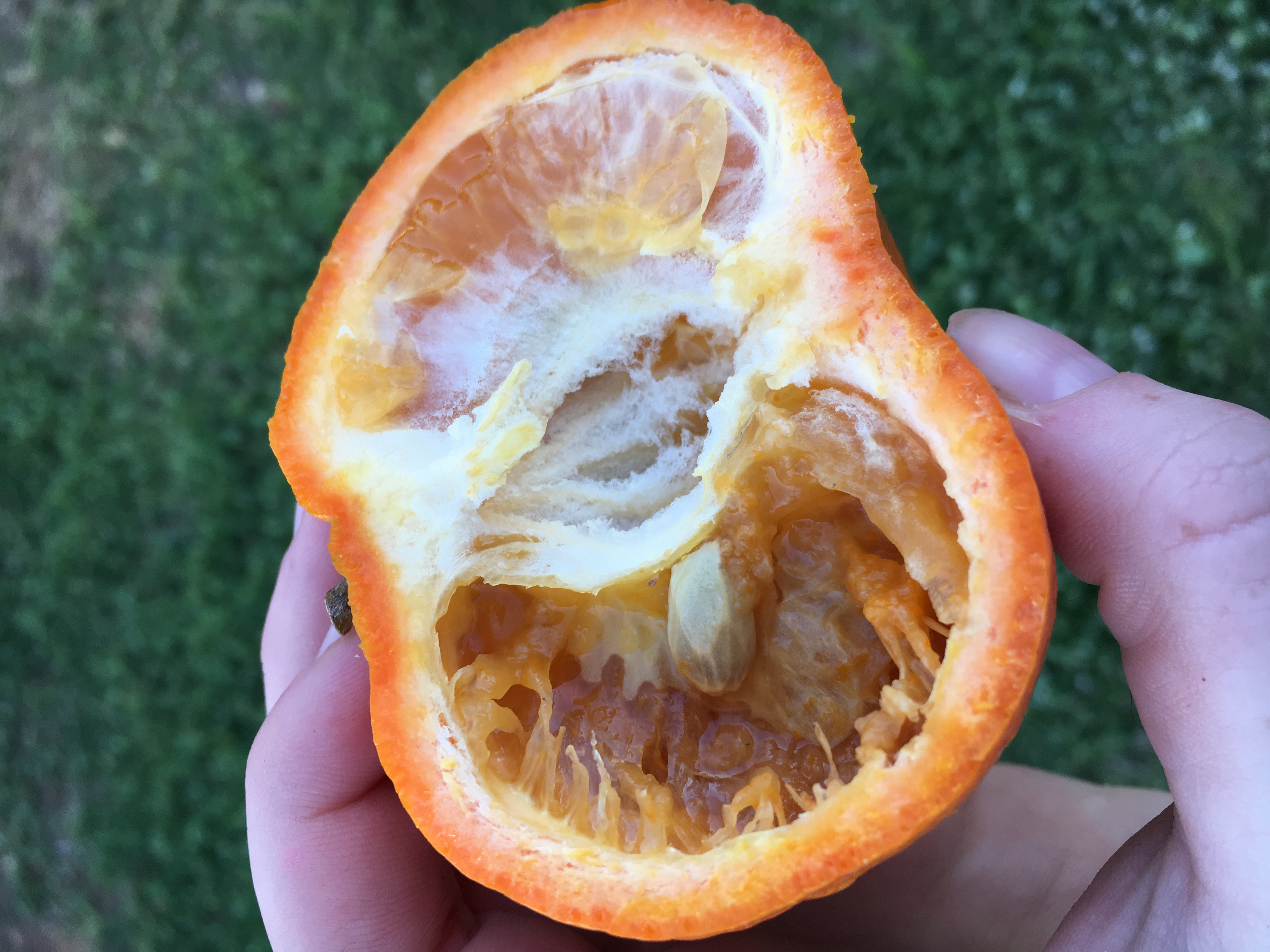
Larvae (maggots)
Mediterranean fruit fly (Medfly) larvae are most easily seen in the flesh of ripe infested host fruit. Larvae are white with a flat pointed head.
The eggs and larvae of Queensland fruit fly (Qfly) and Medfly are almost identical, and larval identification needs to be carried out by an expert.

Adult Medfly
The adult fly is light brown and 3-5 mm long, slightly smaller than a house fly. The abdomen is brown, encircled by two light-coloured rings. The middle of the fly (thorax) has irregular patches of black and silver, giving it a mosaic appearance. The wings are mottled with distinct brown bands extending to the wing tips. The Medfly female has an ovipositor or egg-laying organ but the male does not.
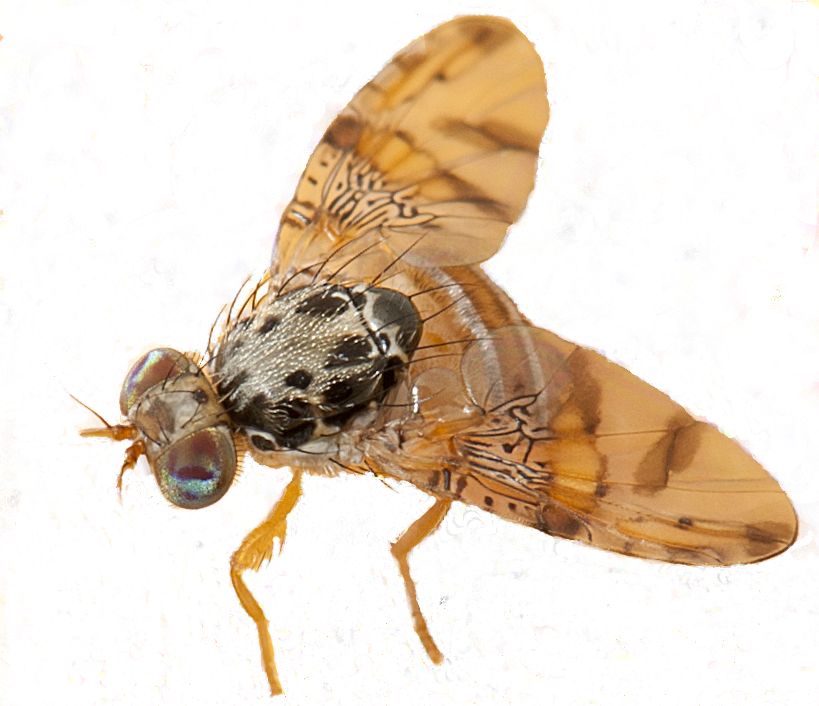
Damage is caused when the female lays eggs into ripe fruit and a resulting larvae infestation occurs. In WA, Medfly is a major problem for commercial orchardists and householders alike and attacks a wide range of fruits, vegetables and nuts.
Adult Medflies can fly short distances. Long-distance spread can also occur when larvae-infested fruit or other host produce is transported to another area.
Understanding and interrupting the Medfly life cycle can be key to controlling spread.
Eggs
Once a suitable host is found, the ovipositor is used to pierce the fruit skin. Batches of 8-10 translucent white banana-shaped eggs are laid into this hole. Eggs are barely visible to the naked eye and take 2–4 days to hatch in summer and 19–20 days in winter. Over their lifetime, adults typically lay around 300 eggs, but can lay up to 800.
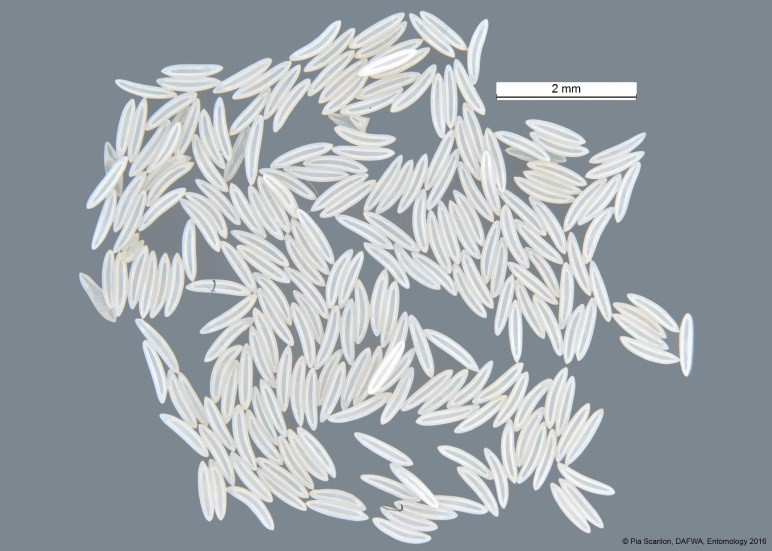
Larvae (maggots)
There are three larval stages (instars) with first instars 1 mm long, quickly reaching 8 mm as third instars. The larvae feed on the fruit causing it to decompose. When fully grown (third instar), larvae stop feeding and leave the fruit, burrowing into the soil to pupate.
The larval stage takes about 14–16 days in summer and 25–45 days in winter.
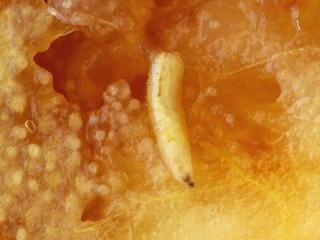
Pupae
Pupae resemble a small brown capsule about 4 mm long. Within the pupa the Medfly slowly develops into an adult. The adult fly cuts through the pupal case and burrows up through the soil. The pupal stage lasts 12–14 days in summer and 25–50 days in winter.
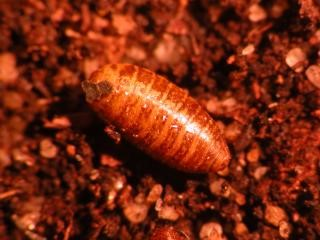
Adults
Adult Medfly may live for 2–3 months and are often found in the foliage of fruit trees, especially citrus. As long as fruit is present, most Medfly will not move more than 50 metres. The males form groups underneath leaves and call for females to mate.
Behaviour and temperature
Medfly activity is dependent on temperature. One life cycle takes 28-34 days to complete in summer and 60-115 days in winter. Fly activity and numbers are greatest during warmer months. Adult Medflies become active when temperatures exceed 12°C. As the temperature rises in spring, increased numbers of adults emerge from the ground and flies become active. If control is not started at this time, Medfly populations will grow and cause problems later in the season.
When temperatures start to fall Medfly can still survive for extended periods as eggs or larvae in fruit, or as pupae in the ground.
Control options for backyard gardeners
Backyard fruit can be a significant source of Medfly. If you are unable to manage Medfly or do not want to harvest your fruit, consider removing unwanted trees. Fruit trees such as stone fruit (apricots, cherries, peaches, plums, nectarines) can be difficult to grow free of fruit fly in areas like Perth where Medfly populations are high.
For control to be effective, it is essential for growers (both commercial and home garden) to dispose of fly-infested or unwanted fruit, including fruit left on the tree. Fruit disposal is the responsibility of the grower. Infested fruit should be picked, and all fallen fruit gathered from the ground.
There is no 'silver bullet' to rid fruit trees in home gardens of Medfly, which is widespread throughout south-west WA. If all property owners in a neighbourhood work together to control the pest, there is a much better chance of keeping populations down so that everybody can enjoy harvesting unblemished fruit.
Treatment or destruction methods include:
- solarising by placing fruit in plastic bags, preferably black rubbish bags so that the heat from the sun kills the eggs and larvae
- freezing for at least 24 hours
- mulching to a pulp consistency
- spraying with a registered insecticide
- boiling and then feeding cooked fruit to poultry or pigs
- placing in water in a container with a film of kerosene or oil for at least 7 days
- burying to a depth of at least 1 m.
Baiting consists of applying coarse droplets of a protein liquid, laced with insecticide, to leaves.
How does baiting work?
Females require a source of protein to mature their eggs and to maintain egg production. They usually obtain protein from fruit juice, bacteria and bird droppings. The baiting technique exploits the need for this protein. Male and female Medflies are attracted to the protein, feed on it, and ingest a lethal dose of insecticide. Baiting targets only adult Medflies, and conserves beneficial insects.
Keep in mind:
- Baiting may not provide control of Medfly in crops that are highly susceptible, or in high pressure areas such as in suburbs with many established fruit trees.
- Female Medflies may find ripening stone fruit more attractive than baits. Effectiveness is increased if applied over a wide area such as in a community baiting scheme – so encourage your neighbours to also bait their trees.
Tips and techniques for baiting Medfly
- You should start during the early stage of fruit development when the fruit is a third of its final size and continue until all fruit has been harvested.
- The organophosphate maldison is registered for use in baits or for spot spraying of foliage, but fruit cannot be picked for four days after spraying. The biologically-derived insecticide spinosad can also be used for baits and spot spraying of the foliage, and with this fruits can be picked on the same day as spraying.
- The bait is applied to the foliage as a coarse spot spray of 60–100 mm for each tree depending on size. Entire tree coverage is not necessary as the flies are attracted to the protein by smell.
- The bait can be applied with a garden pressure sprayer, hand-held spray bottle or flung onto foliage from a bucket with a paint brush. Make sure that the droplets are large: at least 2 mm across.
- As the insecticides used in baits have a short residual life, baits needs to be re-applied at weekly intervals. They also need to be re-applied if there is more than 5 mm of rain.
- Baiting requires care and commonsense precautions. As with any pesticide, precautions should be taken particularly when transporting and handling the insecticide concentrate, and mixing and applying bait material.
Lure and kill devices work in a similar way to baits, exploiting the need for female Medflies to obtain dietary protein for egg production.
Lure and kill devices are not likely to kill all flies present, as the ripening fruit may be more attractive to the female Medfly than the trap contents. Lure and kill devices can be used in conjunction with baiting or physical exclusion.
How do lure and kill traps work?
Traps are hung on trees and the protein in the trap attracts male and female flies. Depending on the design, the flies either drown or obtain a lethal dose of insecticide.
Commercial traps
Nurseries sell a lure and kill device which consists of a plastic container containing a liquid that is attractive to Medflies. The flies enter through small holes in the lid, and eventually drown in the liquid. Freshly killed flies float on the surface.
Homemade traps
Home-made traps for Medfly can be cheap and effective. You can make your own traps out of empty soft drink or water bottles, 2L milk or juice cartons. Remove the label first as it may deter flies or attract young children. Drill, punch or burn at least four holes on opposite sides of the bottle, near the ‘shoulders’. The size of the holes should be 6-8 mm. The trap can be hung from its neck by wire or string to a branch. Fill one-third of the trap with your recipe.
Where to position traps
Homemade or commercial devices should be hung 1.5-2 m above the ground in fruit trees. These do not need to be fruiting at the time. Try to place the device in the shady part of the tree. Some traps can also be placed in nearby non-fruiting trees where flies may shelter.
The attractiveness of food lures extends just a few metres, so traps should ideally be no more than 5–6 m apart. You should hang at least two homemade traps per tree.
Tips and techniques for traps
- The entire contents of homemade traps should be replaced at least weekly, as the trap contents will attract other insects besides Medfly. Meanwhile, a commercial lure is likely to attract Medfly only.
- Traps may dry out during summer and should be topped up with more liquid. If a trap dries out, Medflies may still be attracted but will not be killed.
- When disposing of the trap contents, make sure that you do so away from fruit trees as the liquid may attract Medflies.
Many fruit fly trap recipes are available on the web, or you can use the suggestions below.
Solution 180 g white sugar 1.5 g dry brewer's yeast 920 mL water |
Solution 25 mL imitation vanilla essence 20 mL household ammonia 1 L water |
Solution 3Peel from 6 mandarins or 2 oranges 50 mL household ammonia 1 L water |
Solution 41 tsp borax 1 tsp sugar 2 tsp bran 1 L water |
Physical exclusion involves tying fly-proof bags around fruits, branches or trees.
Tips and techniques for physical exclusion
- Whole trees or fruits can be protected by excluding Medfly with mosquito netting, shade-cloth or nylon flyscreen. Large nets will need to be supported by a frame.
- Frames for nets that enclose whole trees can be made from polyethylene irrigation pipe (5 cm in diameter), which does not lose its shape in the sun. The frame is constructed by crossing over and tying together 2 lengths of pipe over the tree. Frames can be secured in the ground by slipping the end of poly-pipe over posts, such as star pickets embedded in the ground.
- Individual fruits or branches can be protected by making bags or sleeves out of cloth such as gauze curtain material, muslin or mosquito netting. Tie off bags around the base of the fruit or branch with a twist tie or string.
- Commercial fruit fly exclusion bags are also available in either waxed paper or cloth.
- Covers should only be left in place while fruit is ripening to avoid damage to the tree.
Control options for growers
Medfly is a major problem for backyard and commercial orchardists. There are various methods fruit growers can use to reduce and control Medfly populations.
Controlling Medfly is mandatory in some areas of Western Australia including Carnarvon, Armadale, Kalamunda, Mundaring, Serpentine-Jarrahdale and Swan.
Bait sprays consist of a protein laced with small amounts of insecticide to kill the adult fruit fly. Females require protein to mature their eggs and to maintain egg production throughout their lifetime.
Bait sprays are highly effective at suppressing the fruit fly population, and for this reason are used in sterile insect release and area-wide management programs worldwide. Bait spraying is most effective if begun early and applied consistently to the entire orchard.
When do I need to start?
- Commence weekly baiting when fruit is half size. Where Medfly pressure is high, start after fruit set.
- Apply baits at least once per week as the insecticide mixture is not effective beyond this. Do not apply bait to the same tree more than once a week, due to potential problems with phytotoxicity.
- Bait twice weekly if trapping indicates that fly numbers are constantly > 1 fly/trap/week. Alternate the rows or trees you spray, so you are only baiting any tree only once in any one week. Look for stings and consider cover spraying if necessary.
- Baiting your entire orchard is more effective than baiting just a few blocks.
- Choose a regular morning and day for your baiting, and program it into your orchard management plans.
- Reapply bait if it rains.
- Bait wind breaks and other non-fruit evergreen trees in the orchard.
Best time of day to bait
Bait in the morning to the foliage (aim for middle to top of tree) so that fresh bait is available when flies start to feed.
When can I stop baiting?
Continue baiting a block for at least four weeks after harvest, to ensure that flies emerging from the soil are killed.
Continue to treat any citrus trees (regardless of whether they have fruit) while fruit is on the other trees, as citrus are favoured resting places for Medfly.
Baiting in autumn is also recommended as Medflies present are the source of next year's population.
How much bait do I apply per hectare?
This depends on the product: from 1 up to 20 L/ha.
What can I use?
There are two key components to a foliar bait mixture for controlling Medfly: the protein to attract the fruit fly to feed, and a small amount of an insecticide to kill the fruit fly.
A third component is something to thicken and stabilise the bait mixture, reported to reduce drying in hot weather and extend the effective life of the bait mixture. This practice is still experimental, and growers should monitor its effectiveness.
Common problems
If Medfly numbers continue to increase, application may be incorrect.
If this occurs, check the following:
- Are you using the correct formulation? Check against Tables 1 and 3.
- How old is the insecticide and protein? Potency or attraction can decrease with time.
- Have you been mixing new batches of bait each time that you use it? The potency of the bait mixture decreases, and all bait should be used on the same day that it is mixed.
- What is the pH of your water? High pH can degrade some insecticide formulations rapidly. A pH range between 5.6 and 6.5 is preferred.
- Is the nozzle wide enough to deliver a coarse spray? When sprayed, the bait should form large droplets on the foliage of the tree. If droplets are too fine, they will dry out rapidly and loose potency.
- Is enough bait being applied? Are you applying bait frequently enough? Calibrate your equipment to ensure you are putting out what you think you are.
- Has it been a particularly wet season? Rain washes off the bait and it should be re-applied after rain.
- Has orchard hygiene been maintained? If not, Medfly will continue to emerge from infested fruit and re-invade treated areas.
|
Protein |
Example of product names |
Rate of application* |
|
Plant-based protein |
NATFLAV 500® Fruit fly lure Bugs for Bugs Fruit Fly Lure® Flavex® |
Add 700 to 2000 mL of protein for every 100 L of water plus insecticide. Add protein first then add water plus insecticide. The variable rate is to account for variations in label rates and phytotoxicity. |
|
Animal-based protein |
Cera Bait®
|
Continuous stream application: Spot application: |
|
Naturalure |
Naturalure™ fruit fly Bait concentrate |
Naturalure is an ‘all in one’ protein plus insecticide concentrate. For rate and mixing details, see Table 3. |
|
Product |
Example of product names |
Rate of application |
|
Xanthan gum |
Xanthan gum Keltrol gel |
Add 5 g of product per litre of final bait mixture. Dissolve the powder in a small amount of water first, use of a ‘vortex’ mixing unit is helpful, then add slowly to the bait mixture ensuring constant agitation of mixture. |
|
Guar gum |
Guar gum |
|
Crop |
Insecticide |
Example of product names |
Rate of application |
Withholding period (days) after final application |
|
All |
Trichlorfon (500 g/L) |
Dipterex 500SL® Lepidex 500® |
780 mL in 100 L of water plus protein |
2 days |
|
All |
Maldison |
Maldison 500® |
700 mL in 100 L of water plus protein |
3 days |
|
All |
Maldison (440 g/L) |
Fyfanon™ 440EW |
700 mL in 100 L of water plus protein |
3 days |
|
All |
Spinosad |
Naturalure™ fruit fly Bait concentrate |
Mix 1 part Naturalure with 6.5 parts water. This is a complete bait product, so no further protein is required. |
Not required when used as directed |
|
Non-crop vegetation; perimeter baiting |
Spinosad |
Naturalure™ fruit fly Bait concentrate |
Dilute to 1:6.5 or for emergency (eradication) use as a concentrate 1:1.5 parts water. This is a complete bait product, no further protein is required. |
Not required when used as directed |
Insecticide cover sprays are applied as very fine droplets to the entire tree including fruit, but should be considered only if fly numbers increase to unacceptable levels.
Some growers may also apply a cover spray closure to harvest as final insurance against fruit fly damage, particularly to highly susceptible crops such as stone fruit. Cover sprays will not stop the female Medfly from stinging fruit and will kill beneficial organisms as well as pest insects.
Introduction
Cover sprays used to be the main weapon used by orchardists to prevent damage caused by Medfly laying its eggs in their crops. Changing regulations have resulted in growers adopting more wholistic approaches to Medfly control, with cover sprays being but one tool in the armoury.
Bait spraying and orchard hygiene are now recommended as the cornerstone for fruit fly control for commercial orchardists as they suppress the entire fruit fly population.
Most cover sprays only kill adult flies on contact, and the population will increase again in two to three weeks if no other control is carried out.
Factors to consider
- Integrated pest management (IPM): Cover sprays are non-selective and kill all insects present in the orchard. Growers need to consider this when planning their overall pest control strategy.
- Bees: Some insecticides are toxic to bees. Always consult the label before applying a product.
- Spray drift: Cover sprays may drift onto other fruit crops and particular care needs to be taken.
- Exporting: Check with your distributor before applying cover sprays, as regulations vary in different markets.
Application
Only apply a cover spray if sustained numbers of Medfly are being caught in traps. If applied prior to harvest, ensure that the withholding period is sufficient as it varies from 3 to 21 days depending on which insecticide is used.
The whole tree, including the foliage and fruit, must be covered with insecticide to the point of run-off. The amount of insecticide used depends on the size of the tree — the larger the tree the more the insecticide required. The smaller the tree, the less is required.
Spray applications should only be applied by trained personnel, using correctly calibrated equipment as per good agricultural practices. Take special care to minimise spray drift onto non-target crops.
For more information on spray applications consult the Australian Pesticides and Veterinary Medicines Authority website or view addition information on avoiding herbicide spray drift on the DPIRD website.
Problems
If fruit is consistently being stung, you should review your control/management program which will help suppress the Medfly population. If Medfly numbers do not drop after a cover spray has been applied check the following:
- How old is the insecticide that you are using? Potency can decrease with time.
- Is the pH of the water right?
- Is the entire tree being treated? You may need to readjust your spray equipment to achieve this.
Minor use permits
To assist in controlling Medfly, several minor use permits have been issued by the Australian Pesticides and Veterinary Medicines Authority (APVMA) that allow the use of certain chemicals in a manner not currently listed on the registered label.
Growers planning to use these chemicals as per the permit, must obtain and maintain a current copy of the permit. Copies of the permits are available from your chemical supply agent or the APVMA website.
Registered cover sprays
Insecticides used as cover sprays to control Medfly are available for a range of fruit and vegetable crops. Tables for several key crops of high susceptibility follow. Consult the APVMA website for information about available permits and registered insecticides for other crops.
Please note that the pesticide fenthion is no longer allowed to be used. The cease use page on the APVMA website has more information.
For stone fruit
Read labels or permits carefully as not all products can be applied to all stone fruit varieties. Read and follow all application conditions listed on the label and permit.
|
Insecticide/ restrictions |
Product name |
Application rate |
Maximum no. applications |
Minimum period between applications (days) |
Withholding period |
Notes |
|
maldison all stonefruit |
Maldison, Fyfanon® (440 g/L) Fyfanon® (1000 g/L) Hy-Mal® (1150 g/L) |
140 mL/100 L water
60 mL/100 L
55 mL/100 L |
3 |
3 |
3 |
APVMA permit 12907 (exp. 31/5/16)
|
|
spinetoram/ all stonefruit |
Delegate® |
20 g/100 L |
4 |
14 |
3 |
APVMA permit 12590 (exp. 31/5/16) |
|
tricholorfon/ all stonefruit |
Dipterex®, Lepidex® |
First spray: Repeat sprays: |
N/A |
7 |
2 |
Use as per label for Qfly control |
|
clothianidin/ all stonefruit |
Samurai® |
40g/100L plus MAXX surfactant at 50 mL/100 L |
2 |
7 |
7 |
APVMA permit 14252 (exp. 30/6/15) |
|
thiacloprid/ stonefruit except peach |
Calypso® |
37.5 mL/100 L |
3 |
14 |
14 |
APVMA permit 14562 (exp. 30/11/18) |
|
thiacloprid/ peach only |
Calypso® |
37.5 mL/100 L |
3 |
14 |
21 |
For pome fruit
|
Insecticide/ |
Product |
Application rate |
Maximum no. applications |
Minimum period between |
Withholding period |
Notes |
|
spinetoram/ all pomefruit |
Delegate® |
20 g/100 L water |
4 |
14 |
7 |
APVMA permit 12590 (exp. 31/5/16) |
|
trichlorfon/ all pomefruit |
Dipterex®, Lepidex® |
First spray: 500 mL/100 L |
N/A |
7 |
2 |
Label registration |
|
clothianidin/ all pomefruit |
Samurai® |
40 g/100 L plus MAXX surfactant at 50 mL/100 L |
2 |
7 |
7 |
APVMA permit 14252 (exp. 30/6/15) |
|
thiacloprid/ all pomefruit |
Calypso® |
37.5 mL/100 L |
3 |
14 |
21 |
APVMA permit 14562 (exp. 3 |
Insecticides for persimmons
|
Insecticide |
Product |
Application rate |
Maximum no. applications |
Minimum period between |
Withholding period |
Notes |
|
maldison |
Maldison, Fyfanon® (440 g/L)
Fyfanon® (1000 g/L)
Hy-Mal® (1150 g/L) |
140 mL/100 L water
60 mL/100 L
55 mL/100 L |
3 |
3 |
3 |
APVMA permit 13815 (exp. 31/5/16) |
|
tricholorfon |
Dipterex®, Lepidex® |
First spray: Repeat sprays: |
4 |
7 |
7 |
APVMA permit 12450 (exp. 31/5/16) |
|
clothianidin |
Samurai® |
40 g/100 L plus MAXX surfactant at 50 mL/100 L |
2 |
7 |
7 |
APVMA permit 14252 (exp. 30/6/15) |
For citrus, grapes and jujubes
|
crop/ Insecticide |
Product |
Application rate |
Maximum no. applications |
Minimum period between |
Withholding period |
Notes |
|
citrus/ dimethoate |
Dimethoate |
75 mL/100 L |
3 |
14 |
7 |
Label registration |
|
table grapes/ trichlorfon |
Dipterex®, Lepidex® |
250 mL/100 L |
6 |
7 |
2 |
APVMA permit 12439 (exp. 31/5/16) |
|
jujube/ trichlorfon |
Dipterex®, Lepidex® |
First spray: Repeat sprays: |
4 |
7 |
7 |
APVMA permit 12450 (exp. 31/5/16) |
Attract-and-kill and mass trapping devices are population suppression tools for pests such as Medfly. DPIRD has been working with industry to further develop these useful tools in the fight against fruit flies.
Background
Overseas, the efficacy of attract-and-kill and mass trapping has been demonstrated in crops attacked by Medfly including apple, peach and citrus.
Attract-and-kill devices lure insects to a surface coated with insecticide, whereas mass trapping devices retain insects inside the bait station.
Attract-and-kill and mass trapping devices can contain either wet or dry food lures. Male and female flies attracted are killed by obtaining a lethal dose of insecticide when they walk across or enter the device, or drown in the liquid inside it.
These techniques are effective when combined with bait spraying, however the efficacy of both systems is highly dependent on pest density population.
Make sure that you dispose of the contents and used lures away from fruit trees or potential Medfly hosts as the contents may still attract fruit flies.
What is available?
Several mass trapping and attract-and-kill devices are currently available to be used by commercial fruit growers against Medfly in Western Australia:
CeraTrap®
CeraTrap® is registered for mass trapping in Australia and contains a wet food lure. The trap body consists of a plastic base and yellow lid, and the liquid lure is contained within the base. Flies enter through small holes in the lid and eventually drown in the lure. Freshly-killed flies will float on the surface.
CeraTrap® should be installed at the rate of 25 to 150 devices per hectare, depending on crop susceptibility. The higher the susceptibility, the higher the rate. For example, stone fruit in a high pressure area might require 150 devices per hectare. As the CeraTrap® uses a wet liquid lure, the trap can dry out during summer and should be topped up with more liquid as required.
When dry, CeraTrap® still attract Medflies, but they will not be killed.
CeraTrap® is available in major warehouses and rural merchant stores in Western Australia.
Magnet MED™
Magnet MED™ or MagMED is an attract-and-kill’ system for use against fruit fly in pome and stone fruits and table grapes. MagMED devices consist of a plastic envelope coated with the pyrethroid insecticide deltamethrin. Flies are attracted by the odour emitted through holes in the envelope by a sachet of Biolure® Unipak (containing ammonium acetate, putrescine and triethylamine) inserted into the envelope.
The recommended application rate for this device is 50–75 devices per hectare depending on crop and pest level. For areas of high infestation and higher value crops such as stone fruits, the recommended is 75 devices per hectare.
A 3-year large scale study in pome and stone fruits carried out by DPIRD showed that these Medfly control devices remain effective for up to 5-6 months, however, it is recommended to use this device in combination with bait-spraying particularly in high infestation and higher value crops to achieve good control of fruit fly.
MagMED is distributed by Organic Farming Systems and available only to commercial growers for use under a research permit and in supervised domestic situations.
Monitoring forewarns growers of changes in the fruit fly population, and if comprehensive records are kept, they can be used to understand seasonal abundance patterns and to identify recurring 'hot spots'.
Male lure
- Male Medflies are attracted to trimedlure, which is available commercially as plugs or wafers.
Female lure
- Female lures are based on food attractants. They can also attract some males when Medfly populations are high.
- Biolure and Unipak are mixes of three attractant chemicals available commercially: trials indicate that there is little difference in attractancy between them.
Trap types
- A wide range of traps are commercially available, and new fly traps come out all the time. Most of these have a yellow base and a clear plastic lid.
Killing flies in traps
A range of killing methods can be used:
- DDVP (diclorvos) is commercially available. It knocks down and kills insects entering the trap.
- Sticky trap inserts.
- Propylene glycol is better than water as it does not evaporate as quickly.
- Some newer traps already have the killing agent incorporated into the lid.
How often are lures replaced?
- Female lures and DDVP should last for at least 3 months. Male lures may need to be changed after 8 weeks.
- When changing lures, make sure that you use gloves, and dispose of the lures away from the traps.
Trap placement
- Research suggests that at certain times of the year, for example, early in the season, more males are trapped than females. By using both types of traps, you increase the sensitivity of your monitoring program.
- Hang traps in pairs (one male, one female) in fruit trees about 1.8 m from the ground. Each trap in the pair should be at least 25 m apart.
- Place at least 1 trap per hectare, or 1 trap per block.
- You can move traps from blocks a few weeks after picking, to the next block where fruit is ripening.
When do I start monitoring?
- Start monitoring from fruit set and check traps weekly. Keep records of how many flies are caught in which traps. This information is usual for identifying 'hot spots' within the orchard, and for reviewing your fruit fly management program.
Male or female?
View the 'About medfly' section of this page to view an image showing the difference between males and females.
- Almost all flies caught in male traps will be male. However, male and female Medfly can be trapped in female traps.
- Males have ‘clubs’ on their head, females do not. Females also have ovipositors (used to insert eggs into fruit) and males do not.
What do the trap catches mean?
- If no flies are being caught, this means that there are none to few Medfly present on the orchards. However, stone fruit may still be affected by the few flies that do not move to traps. For this reason, you should also check fruit for stings.
- More than 1 fly - start baiting.
- Sustained high fly numbers indicate that there is a major problem. Review your Medfly management, for example bait application, orchard hygiene and consider using a cover spray.
How many traps do I need?
- At least 2 traps per hectare (one male, one female), with a minimum of 4 traps per orchard (two male, two female) are recommended.
Medfly requires a suitable host fruit in which to lay eggs for the larvae (maggots) to develop. If there are no suitable host fruits available, the adult fruit fly cannot lay eggs, and the breeding cycle is broken.
By removing and destroying infested fruits, further development of eggs and larvae is prevented. This also reduces the number of fruits you have to protect with other measures, thereby reducing control costs.
Introduction
There are three parts to good orchard hygiene (or sanitation):
- removal of non-commercial trees
- removal of unwanted fruit from the orchard
- correct disposal of reject fruit from grading/packing.
Non-commercial trees
All growers should review their orchards each year. It is recommended that stray trees along fencelines, around sheds or other buildings be removed, along with uneconomic trees.
For stone and pome fruit orchards, citrus trees are the biggest risk as they offer overwintering ‘bridges’ for Medfly, providing shelter and host fruit during the cooler months when deciduous trees are dormant. It is highly recommended that pome or stone fruit growers do not grow citrus on their orchards unless they are grown for commercial reasons.
Growers should also remove unwanted trees from within commercial blocks. For example, a single peach tree growing within a nectarine block can be a significant source of Medfly later in the season.
Non-commercial trees must be included in your Medfly control program.
Unharvested fruit
Any susceptible fruit must be removed and suitably disposed of, or destroyed in situ, on a regular basis during the season. This should be carried out weekly as a minimum.
Any unwanted fruit left on the trees after the final harvest should also be removed and disposed of immediately following final harvest as research has shown that these fruits often become infested. Apples and persimmons in particular are very good overwintering hosts for Medfly as they can hold their shape for over five months.
Destruction of fruit
Options for the destruction of fallen/unwanted fruit include:
- Soak fruit in a vat of water topped with kerosene, to cut off oxygen transfer for four to five days, then bury.
- Cook or puree the fruit (small quantities only).
- Freeze or store in a coolroom (below 0°C) for at least 20 days.
- Deep burial — must be greater than 1m deep and covered immediately.
- Mulch the fruit in the rows using a slasher or flail mower. Check while you are doing this that the fruit is being well mulched.
- Use poultry to clean up fallen fruit but check their effectiveness over the entire orchard.
Rejects from grading/packing lines
Not all fruit that is harvested makes it past grading standards, and significant quantities can accumulate daily from a grading/packing line. You must dispose of this fruit.
Rejected fruit should ideally be disposed of daily. Reject fruit can be disposed of in a similar way to fallen fruit. If you are going to mulch, spread the fruit out thinly and ensure it is mulched well. This is best done away from the orchard if possible.
If this is not possible, put extra monitoring traps around the area where you destroy the fruit to check on the effectiveness of your treatment.
WA’s control of Medfly is supported by general and specific surveillance and specific import requirements to prevent its entry
Legal duty to report
Ceratitis capitata (Wiedemann, 1824) is a declared pest in WA.
It is a prohibited organism under section 12 of the Biosecurity and Agriculture Management Act 2007.
This means that any person who finds or suspects the presence of Medfly must report it to DPIRD.
Report Medfly
Early detection will help protect local fruit and WA horticulture. If you suspect your plants are stung by or infected with Medfly or any other fruit fly, report it in one of the following ways.
Contact us
-
Commercial Medfly Enquiries Only

